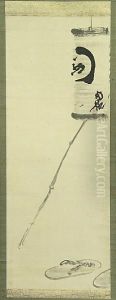Odake Kokkan Paintings
Odake Kokkan was a distinguished Japanese painter, born in 1880 in Tokyo, Japan. Growing up during a period of significant cultural and social change in Japan, Kokkan was part of the Meiji era when the country was rapidly modernizing and opening up to Western influences. This context deeply influenced his artistic development and the themes of his work. He was known for his skillful blend of traditional Japanese techniques with Western painting styles, a characteristic that made his work stand out in the Japanese art scene of the time.
Kokkan received his artistic training at the Tokyo School of Fine Arts, where he was exposed to a variety of art forms and techniques. It was here that he began to develop his unique style, which would later be recognized as a significant contribution to the nihonga movement. Nihonga was a term coined during the Meiji period to differentiate Japanese painting that used traditional techniques and materials from Western-style painting, known as yōga. Despite this distinction, Kokkan and other nihonga artists were not averse to experimenting with Western techniques and incorporating them into their work.
Throughout his career, Kokkan was celebrated for his beautiful landscapes and portraits. His paintings often depicted scenes of nature and rural life, reflecting a nostalgia for the disappearing traditional Japanese way of life amidst rapid modernization. He was also known for his mastery of color, using the delicate and nuanced shades of natural pigments to create depth and emotion in his works.
Kokkan's contribution to Japanese art was recognized during his lifetime, and he was awarded several prestigious awards, including accolades at the Bunten, an official art exhibition sponsored by the Japanese government. His works were not only popular in Japan but also gained international recognition, contributing to the global understanding and appreciation of Japanese art.
Odake Kokkan passed away in 1945, leaving behind a legacy that continues to influence and inspire artists both in Japan and around the world. His work remains an important part of Japan's cultural heritage, embodying the delicate balance between tradition and modernity that characterized the Meiji period. Through his paintings, Kokkan captured the beauty of Japan's landscapes and the spirit of its people, making a lasting contribution to the world of art.
